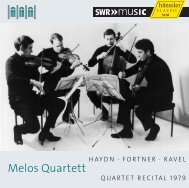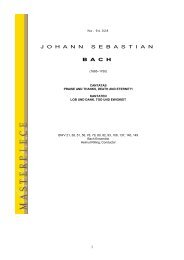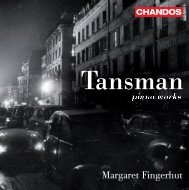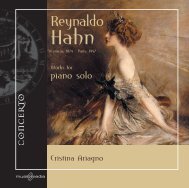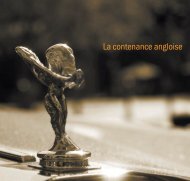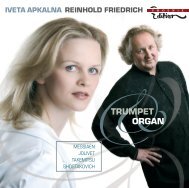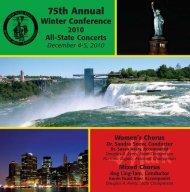You also want an ePaper? Increase the reach of your titles
YUMPU automatically turns print PDFs into web optimized ePapers that Google loves.
himself saw Cmen as "a wench who, from the age of<br />
twelve, had been messing about in the gutter with the<br />
boys". Neverlheless, Else Brems caried through her<br />
own more sophisticated interyretation of the figure,<br />
suppofied by the conductor Leo Blech, and won the<br />
approval of the audience as well as the critics. In 1944<br />
she made several recordings ofthe Habanera (I, I ), and<br />
the Seguidilla (I,2). Because ofthe war, the recordings<br />
were done in the rather uncouth Danish translation'<br />
instead ofthe original French Nonetheless, Else Brems<br />
managetl to sing these famous rias with an effortless<br />
elegance strongly suggestive of a later, famous Cmen,<br />
Victoria de los Angeles. It is noticeable, indeed, that<br />
both are outstanding lied singers, and as such preoccupietl<br />
with the subtle interplay between music and<br />
text rather than with a display of vocal brilliance. For<br />
her Camen in The Royal Theatre Else Brems had five<br />
different Don Jos6s: Niels Hansen, Marius Jacobsen'<br />
Thyge Thygesen, Stefan Islandi, and Erik SjOberg. Add<br />
to these Otte Svendsen, who sings the part in the present<br />
recording.<br />
On several occasions. El.e Brem\ srng tie two famous<br />
Dalila arias at concefi perfomances of SainlSadns's<br />
Samson et Dalila.-fhere tre comparatively few operatic<br />
mias for mezzo-soprano suitable for such performances.<br />
but the Dalila rias with their seductive' lyrical<br />
melodies suited Else Brems's voice to perfection The<br />
recording is in French, which is, presumably, due to<br />
the fact that she never sang the part on stage (I' 3&4)<br />
In 1939. on her return from America, she was given<br />
the part of Orpheus tnGltck's Orfeo ed Eurtdice atthe<br />
Royal Theatre. We possess a pdvate recording from a<br />
concert pedomance on Danish radio in 1948 at which<br />
she sang the part in French. This demonstrates clearly<br />
how perfectly her voice suited this classical bel canto<br />
part (I,7). From the same concert we have another<br />
recording of Else Brems singing Comelia's first aria<br />
from Handel's Giulio Cesare,pefiomed, in Danish' at<br />
the Royal Theatre in 1947. Cornelia has just lemt that<br />
her husband, Pompeius, has been murdered' and she<br />
gives vent to her sonow in a beautiful cantilena which<br />
EIse Brems endows lrom first to lasl note wilh a cenain<br />
mournful quality, uniquely her own. (I'6).<br />
She felt at home even in comic opera and operetta She<br />
was a "gorgeous" Euridice in Offenbach's Orphde aux<br />
enfers, andtn 1940 she was the "lovesick' wonderfllly<br />
voluptuous, young" watchmaker's wife in Ravel's<br />
L'heure espagnole, and ten years later the "lovely'<br />
unchaste" Susannah in Krudige Riisager's Sasanne<br />
built on a theme from The Apocrypha, and of which<br />
the title part was written specifically for her. Other<br />
Danish composers created operas with Else Brems in<br />
mind. Of these the most outstanding is Ebbe Hamenk's<br />
Marie Grubbe from 1940. The stomy life of the<br />
historical Marie Grubbe, a lady ofnoble birth, has been<br />
treated by several Danish writers such as Ludvig<br />
Holberg, H. C.Andersen, and J. P Jacobsen. The libretto<br />
for the opera was written by Fredrik Nygard<br />
who, perhaps because ofthe wil, stresses Marie Grubbe's<br />
love for her native country in several lyrical<br />
passages. One of them "To Denmark", recorded here<br />
from a private recording of a radio concert (I,8)' shows<br />
how perfectly Hamerik understood the quality of Else<br />
Brems's voice. The period was a flourishing one for<br />
Danish opera; Ebbe Hamerik's The Travelling<br />
Companion, afterH.C.Andersen, was put on with Else<br />
Brems as the wicked princess; she sang important parts<br />
in Jprgen Bentzon's Saturnalta, in Knud Jeppesen's<br />
Rosaura, and Johan Hye Knudsen's Church and Organ.<br />
In 1943, in blacked-out Copenhagen George<br />
Gershwin's Porgy and Bess had its turbulent European<br />
premiere. Nazi bomb scues threatened to boycot the<br />
perfomance in which Else Brems, as the firstnon-black<br />
singer, was to sing the part of Bess The perfomance




